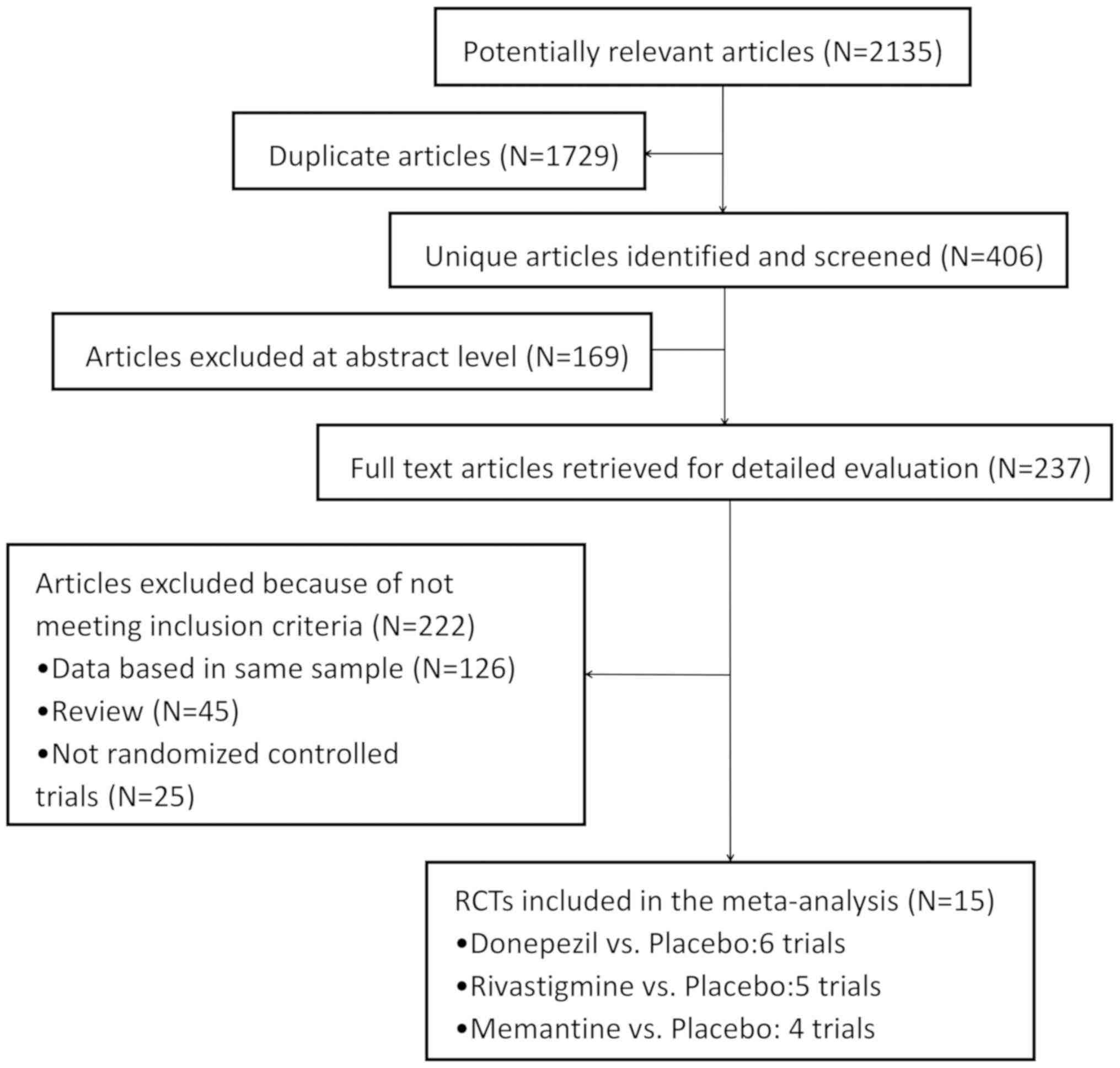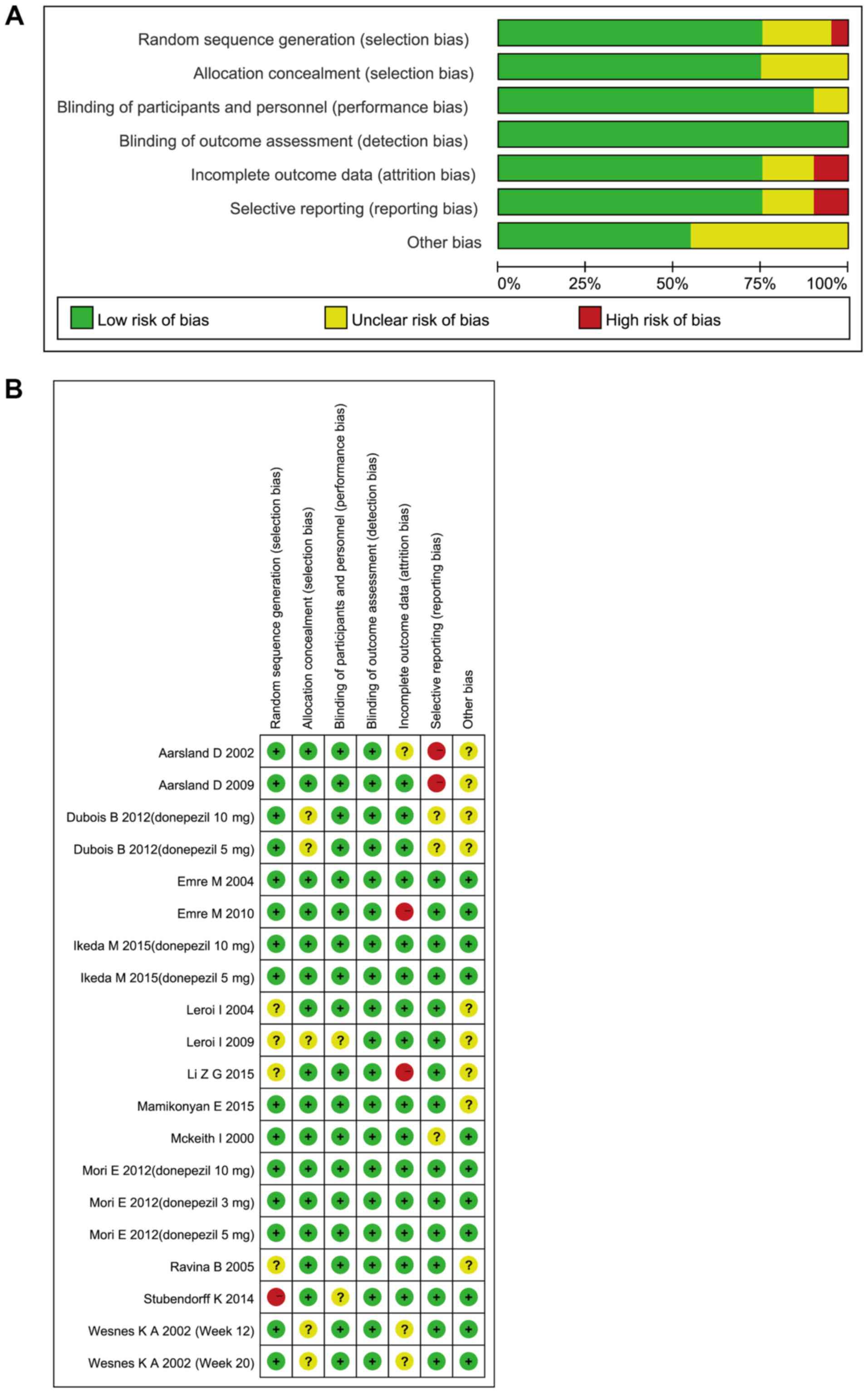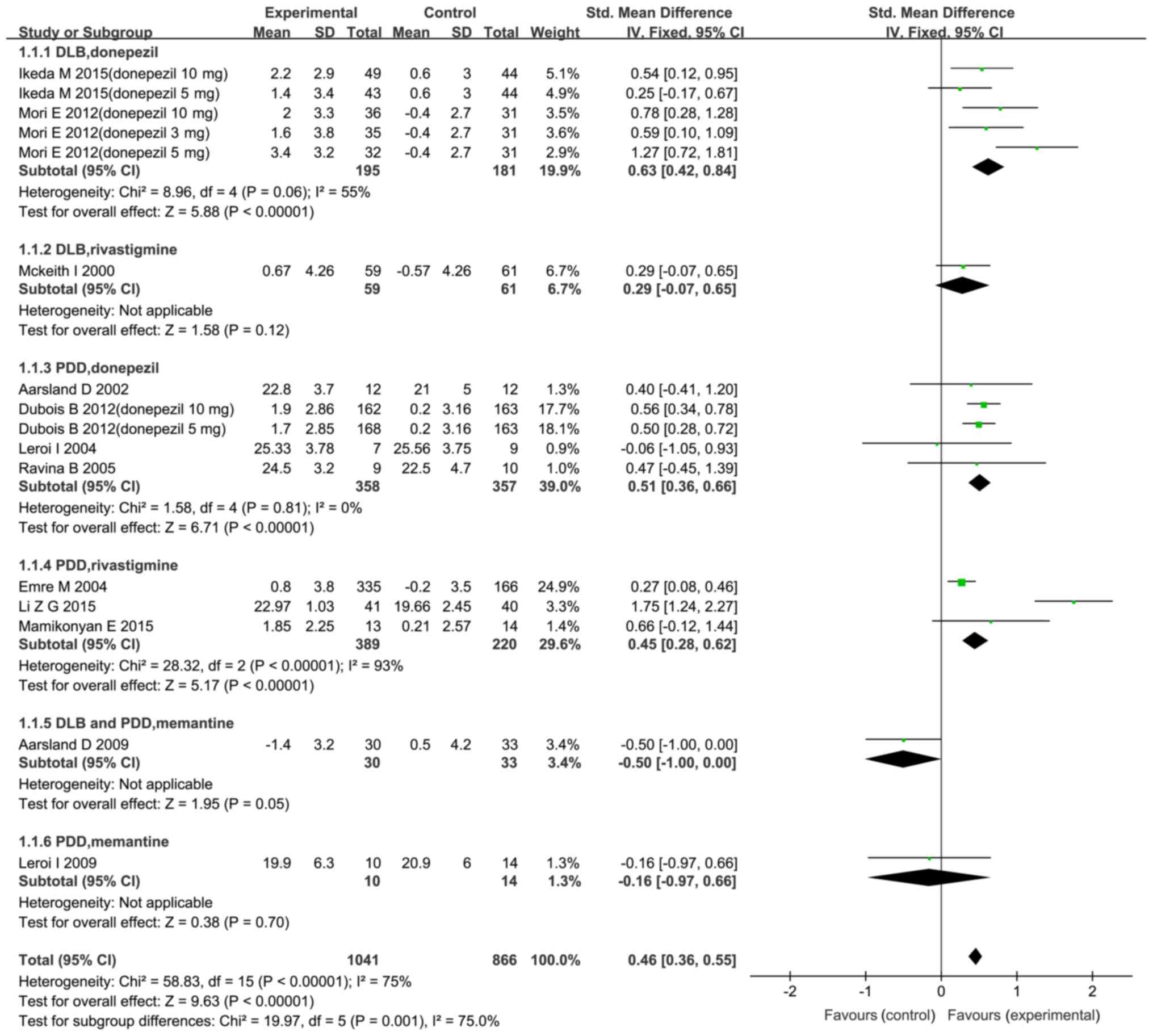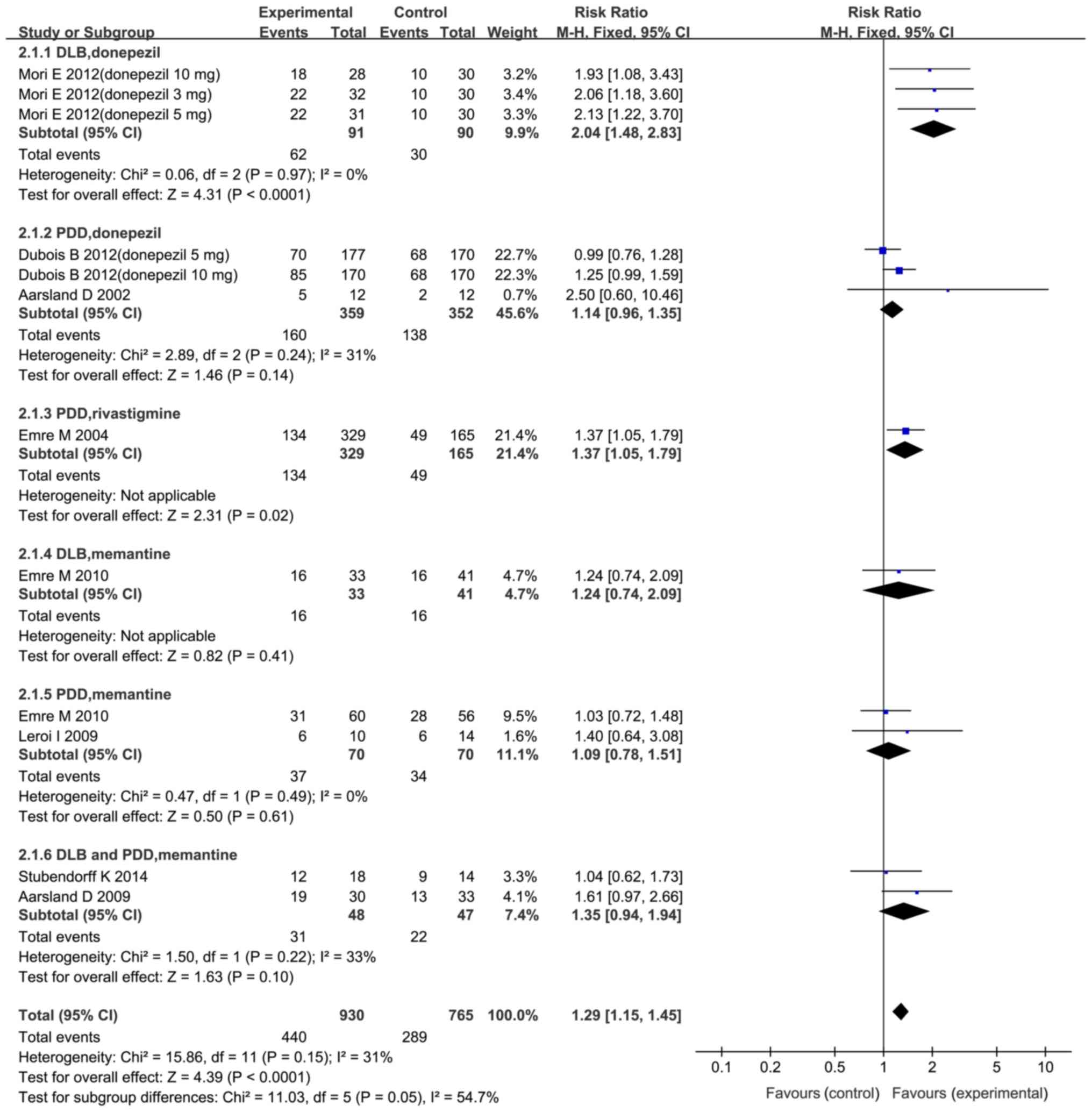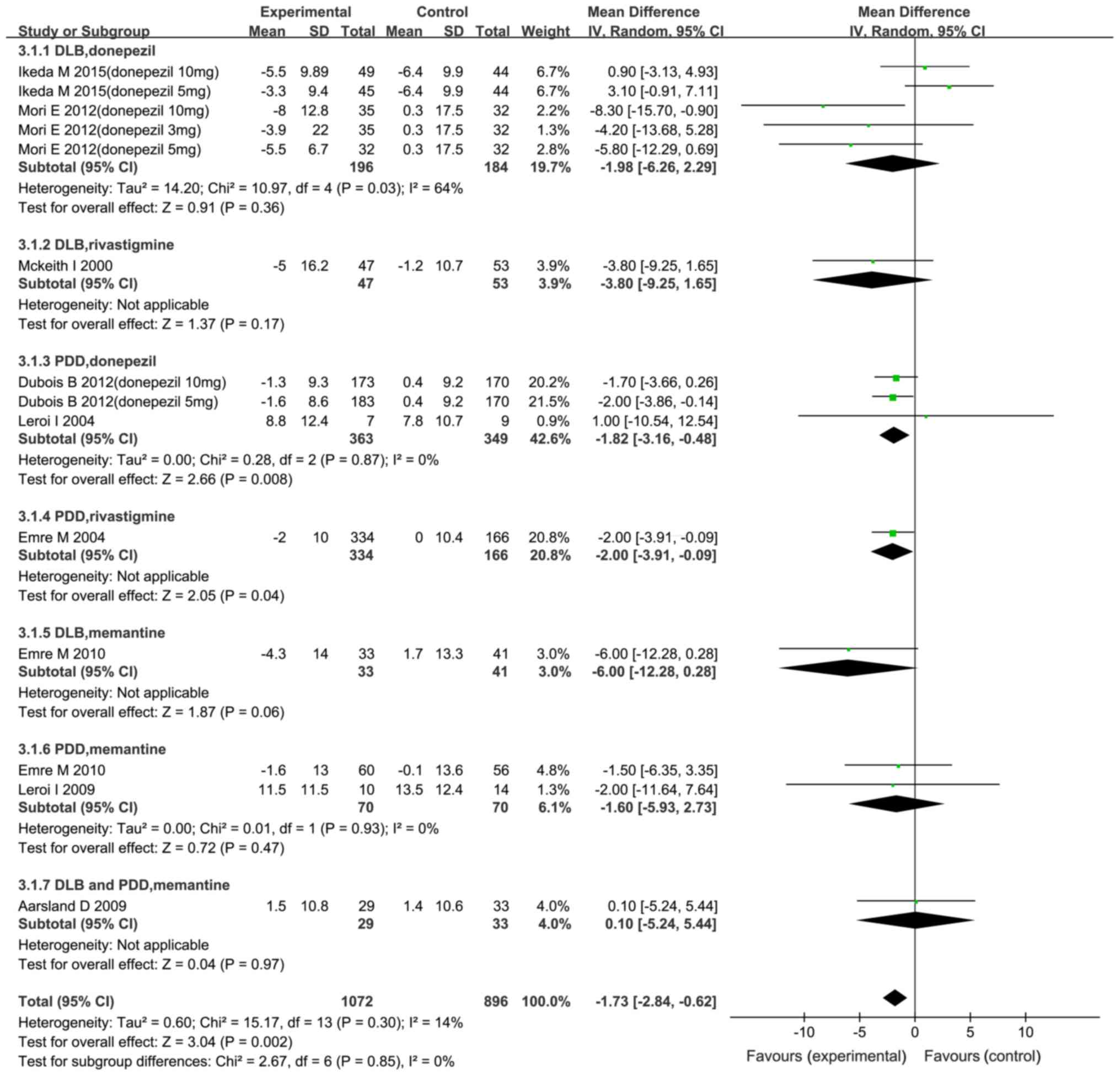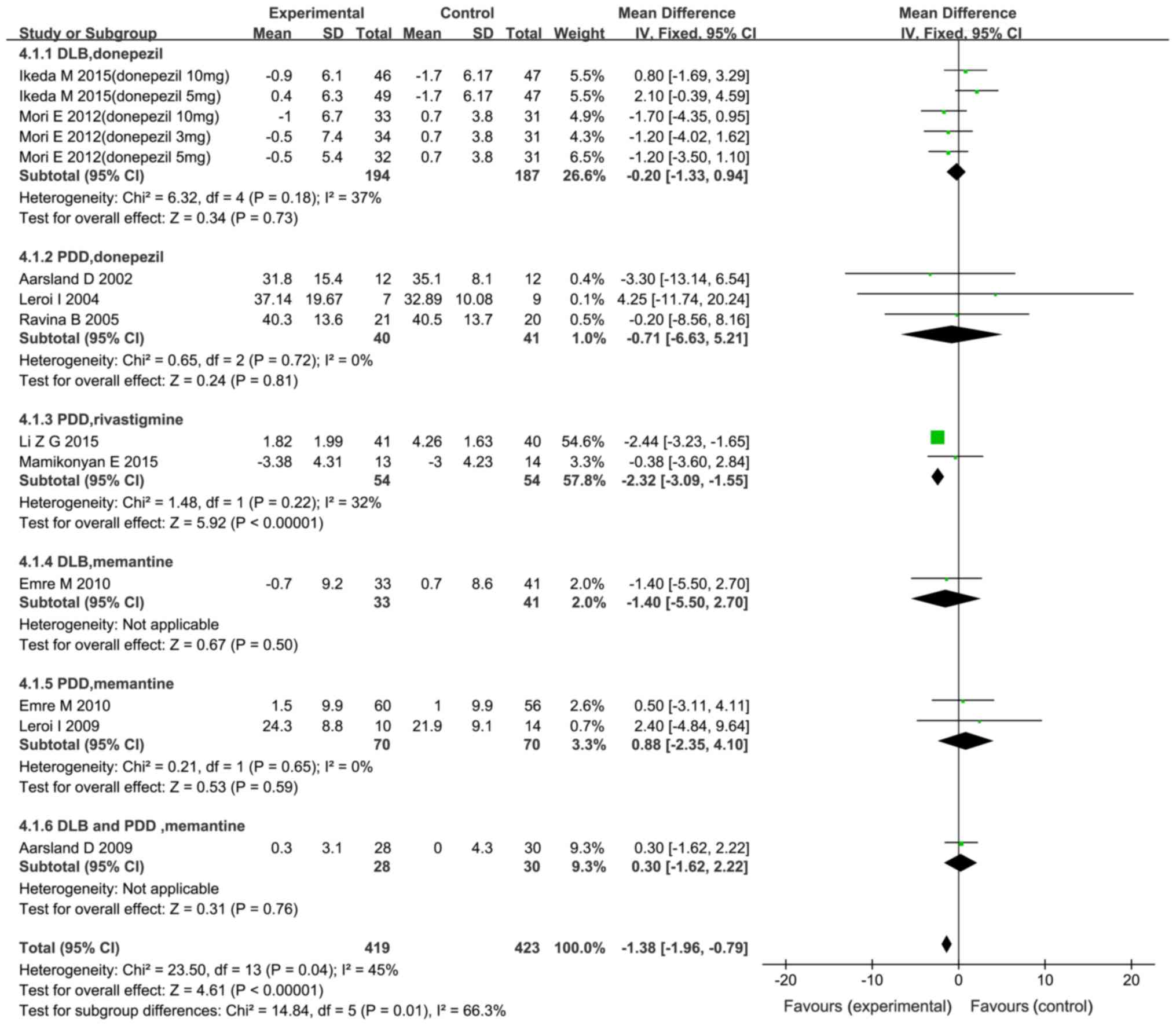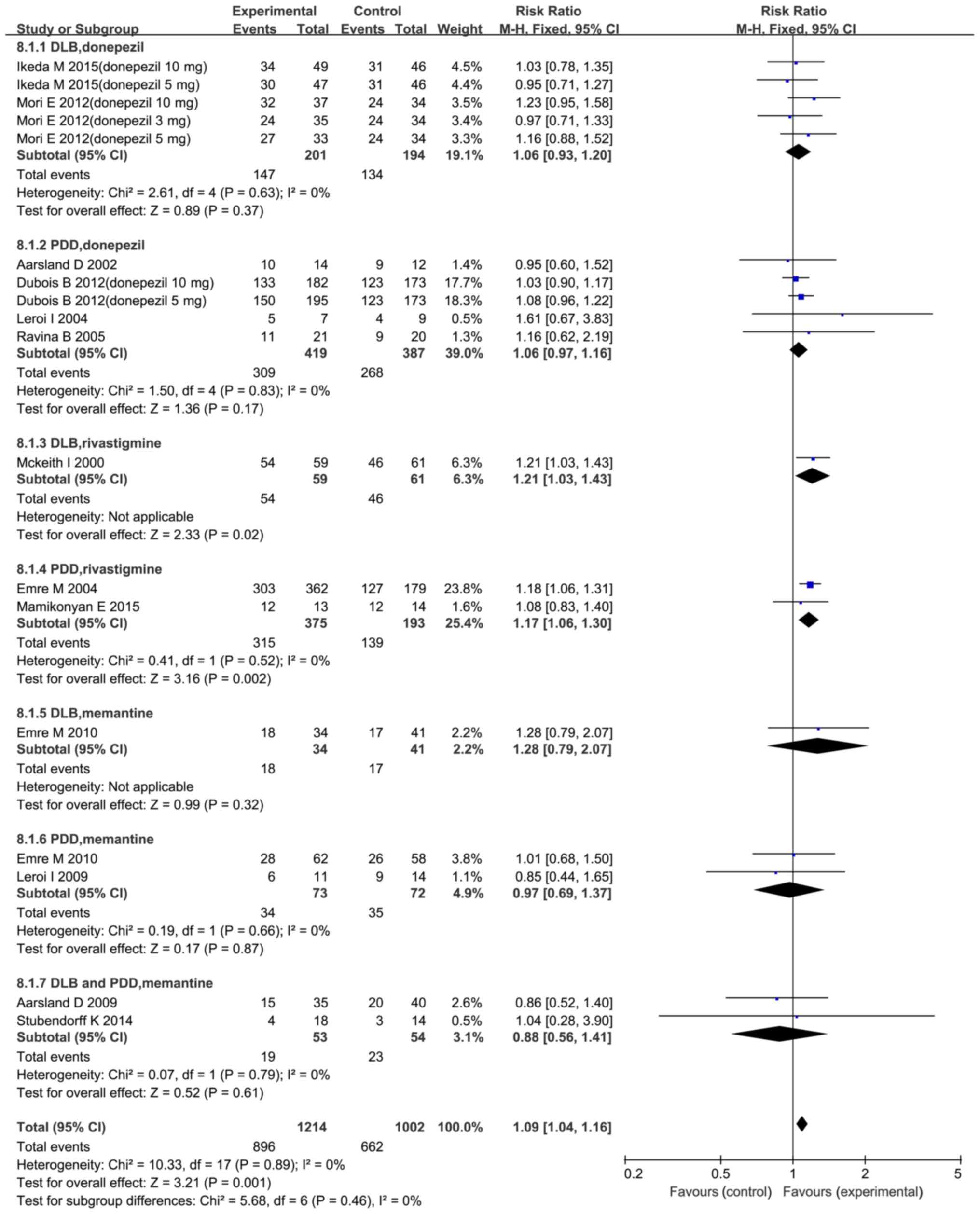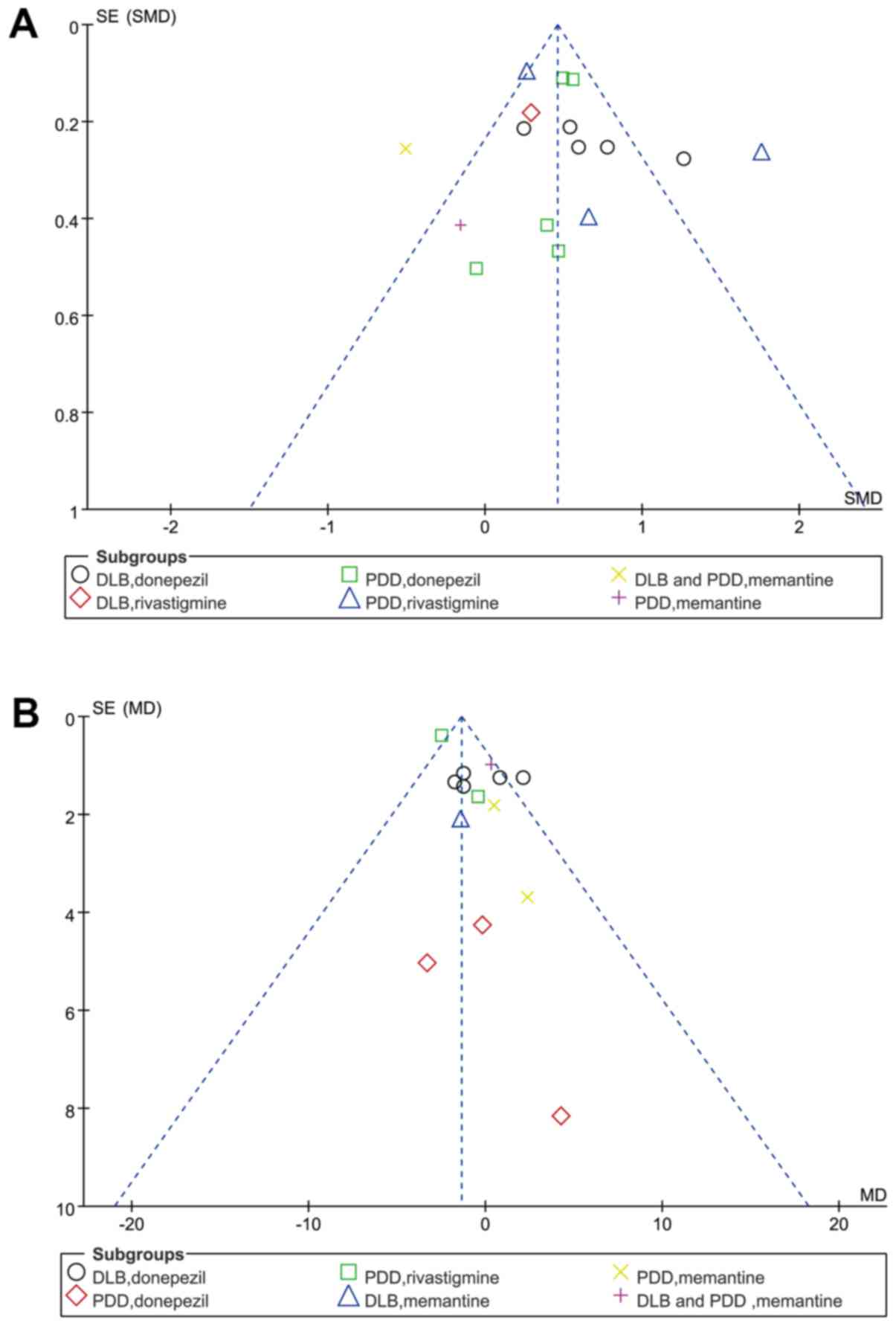Introduction
The most common types of dementia are Alzheimer's
dementia (AD) and Parkinson's disease dementia (PDD), while
dementia with Lewy bodies (DLB) is the second most common type of
dementia, accounting for 15–20% of the global incidence of dementia
(1–3). PDD and DLB are characterized by
accumulation of Lewy bodies in brain cells (4). From a clinical and neuropathological
perspective, DLB and PDD are similar conditions with the same
features, namely dementia, parkinsonism, hallucinations and
fluctuations of attention or arousal (5). They may be distinguished on the basis
of the relative timing of dementia and Parkinsonism. Several
meta-analyses have been performed to examine the efficacy and
safety of cholinesterase inhibitors and memantine, or each drug
separately, on CIND-PD, PDD and DLB (6–9). The
studies reported that cholinesterase inhibitors and memantine
improve the global impression, cognitive function, psychiatric
symptoms or motor function. They evaluated cognitive function via
the use of certain screening tests, including the Mini Mental State
Examination (MMSE) and Montreal Cognitive Assessment (MoCA). To the
best of our knowledge, no previous meta-analysis has focused on
cognitive domains, including attention, processing speed, executive
functions, memory and language. The present study hypothesized that
cholinesterase inhibitors and memantine may also improve the
patients' cognitive domains in addition to global cognitive
function, which may further prove their efficacy. In addition,
falls are a common and severe complication of PD patients and
seriously affect their daily safety, prognosis and quality of life
(10), and thus, the effect of
cholinesterase inhibitors and memantine on falls was also
investigated.
Materials and methods
Search strategy
The Cochrane Library, as well as the Pubmed, Embase
and Web of Science databases, were searched for relevant studies on
clinical trials on cognitive impairment in Parkinson's disease
(CIND-PD), PDD or DLB published before July 2018. The search terms
were as follows: (‘Lewy Body Disease’ OR ‘DLB’ OR ‘LBD’ OR
‘dementia with Lewy bod*’ OR ‘Lewy bodies dementia’ OR ‘Lewy
Bodies’ OR ‘lewy* bod*’) and {‘Parkinson Disease’ OR ‘parkinson*
disease dement*’ OR ‘PDD’ OR [‘cognit*’ and (‘PD’ or ‘parkinson*’)]
OR ‘PD-CIND’ OR (‘CIND’ and ‘parkinson*’)} and [‘Cholinesterase
Inhibitors’ OR ‘cholinesterase inhibitor*’ OR ‘Galantamine’ OR
‘galantamine’ OR ‘galanthamine’ OR (‘reminyl*’ or ‘Nivalin*’ or
‘Razadyne*’) OR ‘donepezil’ OR (‘Aricept*’ or ‘E2020’) OR
‘rivastigmine’ OR (‘Exelon*’ or ‘SDZ ENA 713’) OR (‘Memantine’ OR
‘Namenda’ OR ‘Ebixa’ OR ‘Mntine’)].
Selection criteria
Randomized, placebo-controlled trials that assessed
the efficacy of cholinesterase inhibitors in patients with CIND-PD,
DLB and PDD were selected for the present meta-analysis. The
inclusion criteria were as follows: Patients with PD were included
if they fulfilled the UK PD Society Brain Bank clinical diagnostic
criteria for PD or clinically definite and probable PD diagnosis
(11–14), and if they subsequently developed
dementia, met the Diagnostic and Statistical Manual of Mental
Disorders fourth edition/revised fourth edition or the Movement
Disorders Society criteria at least 1 year after the onset of PD
symptoms (15); DLB patients were
included if they met the consensus guidelines for the clinical and
pathological diagnosis of DLB or revised consensus criteria
(16).
Data extraction and quality
assessment
Two authors independently selected trials for
inclusion in the meta-analysis and extracted information on the
study design, patient selection criteria, drug doses, trial
durations, primary and secondary outcomes, discontinuations and
adverse events in each trial. Disagreements were resolved by
discussion with other team members or by contacting the original
investigators, who were all sent emails with requests to provide
the exact data. For any missing standard deviation data, which were
not obtainable from the primary investigators, estimated values
calculated using the formula no. 8.5.2.3 in the Cochrane handbook
were used in the analysis (17). The
Cochrane criteria were used to assess risk of bias (18), and Grades of Recommendation,
Assessment, Development and Evaluation (GRADE) Profiler software
(version 3.6; Cochrane, London, UK) was used to evaluate the
quality of the studies according to the GRADE methods (19).
Statistical analysis
The meta-analysis was performed using RevMan
software (version 5.3; Cochrane), employing the inverse variance
method. Heterogeneity was assessed using the Chi-squared and
I2 statistical tests, and considered significant if
P<0.05 and I2>50% was obtained by the former and
the latter test, respectively. If I2>50%, a
sensitivity analysis was performed to determine the reasons for
heterogeneity. In this commonly used sensitivity analysis method,
each study included is eliminated one by one, followed by
effect-size calculation, or the inclusion criteria are changed or
certain types of literature are removed prior to effect volume
combination. For continuous data, mean differences (MD) or
standardized mean differences (SMD) were used in combination with
the effect-size (Hedges'g) data. For dichotomous data, the risk
ratio (RR) was estimated along with associated 95% confidence
interval (CI). Overall, SMD and RR with 95% CI were estimated with
Mantel-Haenszel fixed-effects (20)
or DerSimonian-Laird random-effects models (21). When it was confirmed that there was
no heterogeneity, pooled SMD and RR were calculated according to
the Mantel-Haenszel fixed-effects model (P>0.05 or
I2<50%). If there was evidence of heterogeneity,
pooled SMD and RR were calculated according to the
DerSimonian-Laird random-effects model (P<0.05 or
I2>50%). Begg's funnel plots were drawn to evaluate
publication bias.
Results
Study selection and
characteristics
A total of 2,135 records of trials for the treatment
of PD-CIND, PDD or DLB were retrieved from the Cochrane Library,
Pubmed, Embase and Web of Science. Of these studies, a large
quantity was not relevant, including studies regarding other
diseases or interventions, or duplications. A total of 237 records
were considered suitable after screening the titles and abstracts.
Finally, of the 237 full-text articles, only 15 trials [six
donepezil (22–27), five rivastigmine (10,28–31) and
four memantine trials (32–35)] were included in the present
meta-analysis. The flow chart for the selection of studies is
presented in Fig. 1 and the details
of each included article are presented in Table I. The methodological quality of all
studies evaluated using the Cochrane risk of bias criteria is
provided in Fig. 2.
 | Table I.Summary of studies included in the
present meta-analysis. |
Table I.
Summary of studies included in the
present meta-analysis.
| First author
(year) | Total (n) | Condition |
Duration/design | Drug | Age (mean ±
SD) | Males (%) | n of each
group | Dose (mg/day) | Outcomes | (Refs.) |
|---|
| Aarsland
(2002) | 14 | CIND-PD | 10 weeks | DON | 71±3.9 | 92 | 12 | 10 (flexible
dose) | MMSE,
CIBIC-plus, | (24) |
|
|
|
| (crossover
design) |
|
|
|
|
| UPDRS-motor,
NPI |
|
| Ravina (2005) | 22 | PDD | 10 weeks | DON | DON/PLA:
75.0±9.8 | DON/PLA: 100 | 19 | 10 (flexible
dose) | MMSE,
CGI-CADAS-cog, | (27) |
|
|
|
| (crossover
design) | PLA | PLA/DON:
72.1±8.1 | PLA/DON: 60 | 19 |
| MDRS, BPRS,
UPDRS-motor |
|
| Mori (2012) | 140 | DLB | 12 weeks | DON 10 mg | DON 10 mg:
78.6±6.1 | DON 10 mg:
11.1 | 37 | 10 (flexible
dose) | MMSE, WMS-R,
WAIS-III, | (23) |
|
|
|
|
| DON 5 mg | DON 5 mg:
77.9±6.8 | DON 5 mg: 50.0 | 33 | 5 (flexible
dose) | NPI, VF, VPTA,
UPDRS-motor |
|
|
|
|
|
| DON 3 mg | DON 3 mg:
79.6±4.5 | DON 3 mg: 48.6 | 35 | 3 (flexible
dose) |
|
|
|
|
|
|
| PLA | PLA: 78.6±4.7 | PLA: 28.1 | 35 | PLA |
|
|
| Ikeda (2015) | 142 | DLB | 12 weeks | DON 10 mg | DON 10 mg:
77.7±6.8 | DON 10 mg:
42.9 | 49 | 10 (fixed
dose) | MMSE, NPI,
UPDRS-motor | (22) |
|
|
|
|
| DON 5 mg | DON 5 mg:
78.8±5.1 | DON 5 mg: 44.4 | 47 | 5 (fixed dose) |
|
|
|
|
|
|
| PLA | PLA: 77.2±6.1 | PLA: 38.6 | 46 |
|
|
|
| Dubois (2012) | 550 | PDD | 24 weeks | DON 10 mg | DON 10 mg:
70.8±7.46 | DON 10 mg: 75 | 182 | 10 (fixed
dose) | CIBIC-plus, MMSE,
VF, BTA, | (25) |
|
|
|
|
| DON 5 mg | DON 5 mg:
72.0±6.83 | DON 5 mg: 65 | 195 | 5 (fixed dose) | ADAS-cog, NPI |
|
|
|
|
|
| PLA | PLA: 72.9±6.48 | PLA: 65 | 173 | PLA |
|
|
| McKeith (2000) | 120 | DLB | 20 weeks | RIV | RIV: 73.9±6.5 | RIV: 52.5 | 59 | 12 (flexible
dose) | NPI, CGC-plus,
MMSE | (28) |
|
|
|
|
| PLA | PLA: 73.9±6.4 | PLA: 60.7 | 61 |
|
|
|
| Emre (2010) | 199 | DLB and PDD | 24 weeks | MEM | MEM: 74.4±5.8 | MEM: 53.1 | 96 | MEM: 20 (fixed
dose) | ADCS-CGIC, NPI,
UPDRS | (34) |
|
|
|
|
| PLA | PLA: 72.5±7.0 | PLA: 57.6 | 99 |
|
|
|
| Leroi (2009) | 25 | PDD | 16 weeks (from | MEM | MEM: 76.7±7.8 | MEM: 36.4 | 11 | MEM: 20
(fixed) | MMSE, NPI, UPDRS-3,
CIBIC-Plus | (32) |
|
|
|
| 17 weeks to 22
weeks: Off drug) | PLA | PLA: 74.7±7.9 | PLA: 4.3 | 14 |
|
|
|
| Leroi (2004) | 16 | PDD or | 18 weeks | DON | DON: 66.2±9.3 | DON: 85.7 | 7 | 10 mg (flexible
dose) | Cognitive domains,
VMI, NPI, | (26) |
|
|
| CIND-PD |
| PLA | PLA: 70.8±11.8 | PLA: 44.4 | 9 |
| UPDRS-ADL, Motor
function, Complication of treatment |
|
| Emre (2004) | 541 | PDD | 24 weeks | RIV | RIV: 72.8±6.7 | RIV: 64.6 | 362 | 12 mg (flexible
dose) | ADAS-cog,
ADCS-CGIC, NPI-10, | (29) |
|
|
|
|
| PLA | PLA: 72.4±6.4 | PLA: 65.4 | 179 |
| MMSE, VF, CDT,
UPDRS-motor |
|
| Mamikonyan
(2015) | 28 | CIND-PD | 10 weeks | RIV patch | 64.3±8.2 | 78.6 | 27 | 9.5 mg (flexible
dose) | ADCS-CGIC, MoCA,
PDRS-motor | (30) |
|
|
|
| (crossover
design) | PLA |
|
| 27 |
|
|
|
| Wesnes (2002) | 92 | DLB | 20 weeks | RIV | RIV: 73.9±6.5 | RIV: 52.5 | 41 | 12 mg (flexible
dose) | DSST, attention,
processing speed, | (31) |
|
|
|
| (crossover
design) | PLA | PLA: 73.9±6.4 | PLA: 60.7 | 51 |
| Stroop Congruent
Test, Trails A/B, Word Association Test |
|
| Li (2015) | 81 | PD-MCI, PDD | 12 months | RIV | RIV: 67.5±not
clear | RIV: 73.2 | 41 | 3 mg (flexible
dose) | MoCA, falls | (10) |
|
|
|
|
| PLA clear | PLA: 66.9±not | PLA: 52.5 | 40 |
|
|
|
| Aarsland
(2009) | 72 | PDD, DLB | 24 weeks (from 17
weeks to 22 weeks: Off drug) | MEM | MEM: 76.9±6.1 | MEM: 79.4 | 34 | 20 mg (flexible
dose) | CGIC, MMSE, NPI,
UPDRS | (33) |
|
|
|
|
| PLA | PLA: 76.2±5.8 | PLA: 71.1 | 38 |
|
|
|
| Stubendorff
(2014) | 75 | PDD; DLB | 24 weeks | MEM | MEM:
73.8±5.5a,
75.2±5.6b | MEM:
75a, 100b | 18 (12/6) | 20 mg (flexible
dose) | Survival | (35) |
|
|
|
|
| PLA | PLA:
76.5±4.7a,
75.6±4.6b | PLA:
66.7a, 60b | 14 (9/5) |
|
|
|
Efficacy outcomes
Global cognitive function
Of the trials included, 12 (10,22–30,32,33)
evaluated cognitive function using the MMSE and MoCA (Fig. 3). The standard mean difference in
participants who received cholinesterase inhibitors or memantine
vs. placebo was 0.46 (95% CI: 0.36–0.55; P<0.00001), suggesting
significant benefits. Regarding different subgroups, benefits were
determined for donepezil in DLB (SMD=0.63; 95% CI: 0.42–0.84;
P<0.00001) and in PDD (SMD=0.51; 95% CI: 0.36–0.66;
P<0.00001), and for rivastigmine in PDD (SMD=0.45; 95% CI:
0.28–0.62; P<0.00001), but not for rivastigmine in DLB or
memantine in either DLB or PDD.
Cognitive domains
A total of seven trials (23,25–27,29,31,33)
examined the cognitive domains of attention, processing speed and
executive functions (Fig. 4A). The
results of the meta-analysis indicated that cholinesterase
inhibitors and memantine provided significant benefits compared
with placebo (MD=1.19; 95% CI: 0.65–1.73; P<0.0001).
Furthermore, three trials (23,26,33)
examined the cognitive domain of memory (Fig. 4B). The meta-analysis revealed that
treatment with cholinesterase inhibitors achieved a significant
improvement in patients compared with placebo (MD=0.24; 95% CI:
0.11–0.37; P=0.0003). In addition, three trials (26,29,33)
examined visuospatial cognition (Fig.
4C). The results indicated that cholinesterase inhibitors did
not improve visuospatial function when compared with the placebo
(MD=0.13; 95% CI: −0.45–0.71; P=0.65). Finally, four trials
(23,25,29,33)
examined the cognitive domain of language (Fig. 4D). The meta-analysis revealed that
cholinesterase inhibitors had a significant effect in patients
compared with placebo (MD=1.44; 95% CI: 0.34–2.53; P=0.01).
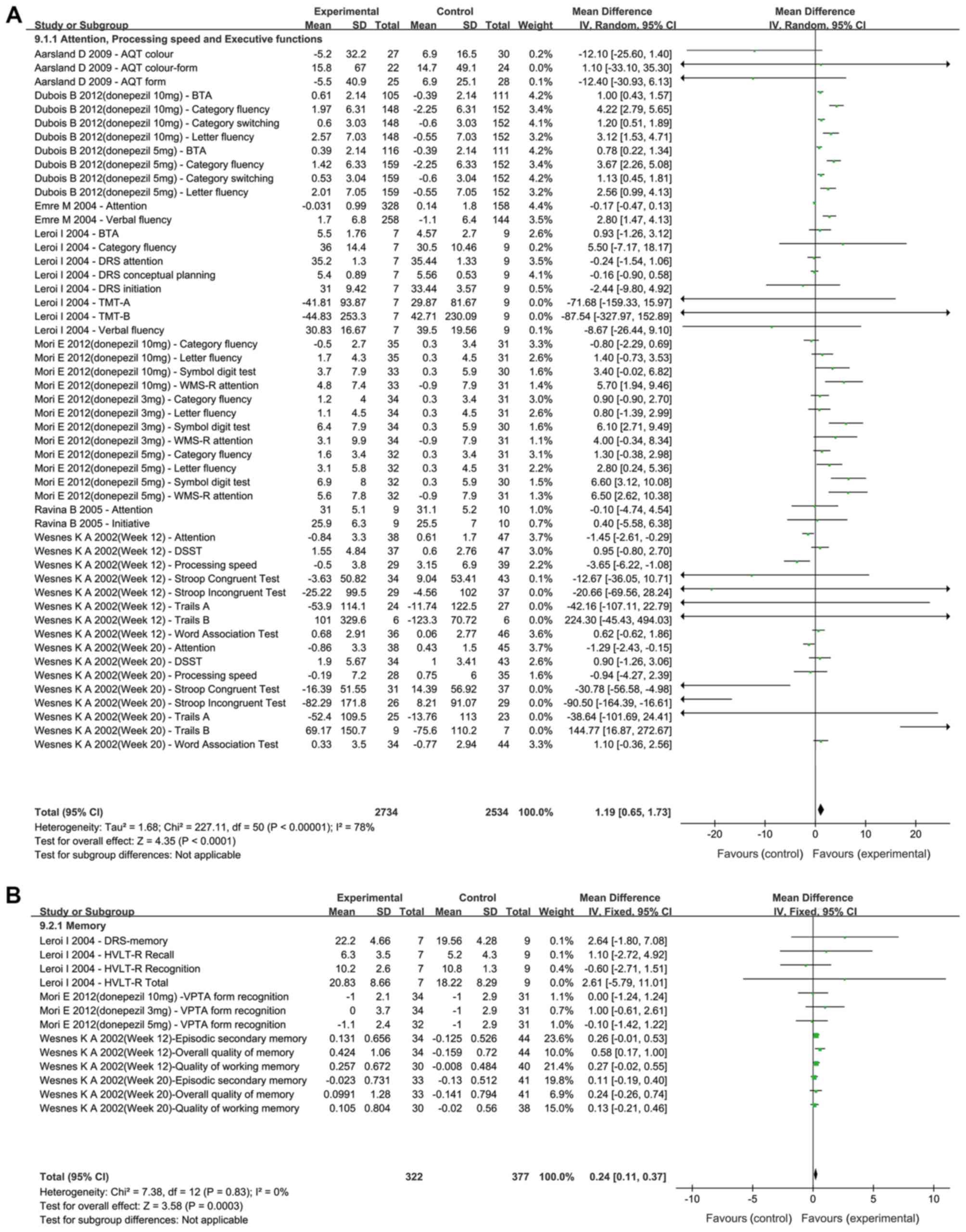 | Figure 4.Forest plot of the meta-analysis for
the cognitive domains of (A) attention, processing speed and
executive functions, (B) memory for donepezil, rivastigmine and
memantine, and (C) visuospatial cognition. The risk ratio is
presented as green squares, with the horizontal lines indicating
the confidence interval. Combined results for all studies are
presented as black diamonds. Forest plot of the meta-analysis for
the cognitive domain of (D) language for donepezil and
rivastigmine. The risk ratio is presented as green squares, with
the horizontal lines indicating the confidence interval. Combined
results for all studies are presented as black diamonds. CI,
confidence interval; IV, inverse variance; SD, standard deviation;
df, degrees of freedom; VPTA, Visual Perception Test for Agnosia;
AQT, A Quick Test of Cognitive Speed; WMS-R, Wechsler Memory
Scale-Revised; BTA, Brief Test of Attention; DRS, Dementia Rating
Scale; TMT, Trial Making Test; DSST, Digit Symbol Substitution
Test; HVLT-R, Hopkins Verbal Learning Test-Revised. |
Global impression
A total of seven trials (23–25,29,32,34,35)
examined the subjects on the Clinician's Global Impression of
Change (CGIC) scale. As indicated in the forest plot in Fig. 5, significant improvements in
participants treated with the drugs compared with the placebo were
revealed (RR=1.29; 95% CI: 1.15–1.45; P<0.0001). Furthermore, in
the following subgroups, significant benefits compared with the
placebo group were identified: DLB treated with donepezil 3 mg
(RR=2.06; 95% CI: 1.18–3.60), donepezil 5 mg (RR=2.13; 95% CI:
1.22–3.70) and donepezil 10 mg (RR=1.93; 95% CI: 1.08–3.43); and
PDD treated with rivastigmine (RR=1.37; 95% CI: 1.05–1.79).
However, no significant benefits were determined for donepezil in
PDD, memantine in PDD and DLB.
Behavioral symptoms
Altered Neuropsychiatric Inventory (NPI) scores were
determined by nine trials (22,23,25,26,28,29,31,32,34). As
presented in Fig. 6, meta-analysis
revealed a significant effect on NPI-10 among all studies
[MD=−1.73; 95% CI: -(2.84–0.62); P=0.002].
Motor function
A total of 10 trials assessed motor function
(10,22–24,26,27,30–32,34).
Compared with the placebo, patients treated with cholinesterase
inhibitors and memantine exhibited improvements in motor function
(Fig. 7). The results of the
meta-analysis suggested a significant effect on patients treated
with drugs compared with placebo [MD=−1.38; 95% CI: -(1.96–0.79);
P<0.00001]. However, only rivastigmine in PDD provided a
significant benefit [MD=−2.32; 95% CI: -(3.09–1.55); P<0.00001],
while donepezil in PDD or DLB, rivastigmine in DLB, and memantine
in PDD and/or DLB did not. Furthermore, a subgroup analysis
revealed that the dose of donepezil had no significant effect in
improving DLB.
Falling
A considerable number of patients experience falls
as a complication of PDD and five of the trials included (10,25,29,32,35)
reported on the quantity of falling. As presented in Fig. 8, the meta-analysis revealed that
cholinesterase inhibitors and memantine did not significantly
reduce falling compared with the placebo (RR=0.74; 95% CI:
0.51–1.08; P=0.12), thereby demonstrating that treatment with the
drugs did not significantly prevent falls.
Adverse events
Adverse events were inconsistently mentioned and
reported by 13 trials (10,22–28,30–32,34,35). The
common adverse events were cholinergic in nature (nausea,
vomiting), aggravation of Parkinson and psychiatric symptoms
(tremor, fall, somnolence, insomnia, hallucinations), urinary tract
infection and respiratory tract infection; however, most adverse
events were mild or moderate. As presented in Fig. 9, the results of the meta-analysis
revealed more adverse events in the treatment groups compared with
those in the placebo group (RR=1.09; 95% CI: 1.04–1.16; P=0.001).
However, among the subgroups, only the rivastigmine group
experienced significantly more adverse events compared the placebo
group (RR=1.18; 95% CI: 1.08–1.29; P=0.0001; data not shown).
Donepezil and memantine did not produce any significant adverse
events compared with the placebo.
Publication bias
The publication bias regarding cognitive and motor
function was determined by drawing Begg's funnel plots (Fig. 10A and B). The shape of the funnel
plots exhibited no obvious asymmetry, which indicated the absence
of significant heterogeneity between these selected studies, and
the pooled results were not influenced by publication bias.
Sensitivity analysis
A sensitivity analysis was conducted to assess the
stability of the results by sequential removal of individual
studies. The heterogeneity (I2=75%) in global cognitive
function is shown in Fig. 3, the
study by Li et al (10) did
not provide the mean differences with SDs, but rather electing to
report the mean and SDs prior to and following treatment, which may
have resulted in data conversion-associated errors. Following the
exclusion of the study, the analysis results did not change. In
Fig. 4A, numerous trials that
examined cognitive domains were then assessed (I2=78%),
it was found that the results did not change following the
sequential removal of individual studies. The authors of the
current study estimated that there was variability in measurement
precision.
Discussion
The present meta-analysis assessed the efficacy and
safety of cholinesterase inhibitors and memantine in the treatment
of CIND-PD, PDD and DLB, which contained four new more articles
than a previous meta-analysis (9).
To the best of our knowledge, the present study was the first
meta-analysis to report on the effect of cholinesterase inhibitors
and memantine in subjects with CIND-PD, PDD and DLB, including
cognitive domains (attention, processing speed, executive
functions, memory, visuospatial cognition and language). The
results indicated that cholinesterase inhibitors had beneficial
effects on attention, processing speed, executive functions, memory
and language, but did not improve visuospatial cognition when
compared with the placebo. Furthermore, memantine was revealed to
improve attention, processing speed and executive functions.
However, cholinesterase inhibitors and memantine did not
significantly reduce falling. Compared with the placebo, more
adverse events occurred in the pooled cholinesterase inhibitors and
memantine group than in the placebo group. However, a subgroup
analysis indicated that only the rivastigmine group experienced
significantly more adverse events than the placebo group, while
donepezil and memantine did not produce any significant adverse
events.
Consistent with the results of previous
meta-analyses, the present study indicated that donepezil was
beneficial for DLB regarding cognitive function and global
impression, but not in any other aspects. Recently published
secondary analyses of donepezil suggest statistically significant
advantages of donepezil over placebo regarding aspects of
Behavioural and Psychological Symptoms of Dementia (BPSD),
improvement of cognitive function and visual hallucinations
(36–38). Manabe et al (36) observed that 10 mg donepezil improved
BPSD in DLB. Mori et al (37)
reported that increasing the dose of donepezil from 5 to 10 mg
enhanced the effect in improving cognitive function in DLB with
little influence on the safety. Ukai et al (38) reported that donepezil was highly
effective against visual hallucinations in DLB.
Galanthamine is another cholinesterase inhibitor. To
date, the potential benefits of galanthamine have remained
insufficiently demonstrated, except for an open-label trial.
Litvinenko et al (39)
reported that galanthamine improved cognitive function, behavioral
symptoms, daily activity and the number of falls. Galanthamine
treatment was not associated with any significant adverse events
when compared with the placebo.
The results of the present meta-analysis revealed
that memantine only had a minor side effect on the participants;
however, this is in contrast to the meta-analysis by Matsunaga
et al (6). This discrepancy
may have been due to the fact that the analysis of the present
study included two further trials, which may have provided more
accurate results. Larsson et al (40) reported that memantine decreases the
probable rapid eye movement sleep behavioral disorder in patients
with DLB and PDD.
Safety is as important as the efficacy of the
interventions in clinical studies. All of the three drugs assessed
in the present study adhered to certain safety standards; however,
rivastigmine produced more adverse events compared with those in
the placebo group. Of note, donepezil and memantine did not produce
any significant adverse events compared with the placebo. None of
the drugs improved or aggravated the symptoms of Parkinsonism
compared with the placebo. Emre et al (41) reported that in a 76-week,
prospective, open-label, randomized study in PDD patients aged 50
to 85 years, rivastigmine exhibited long-term safety.
Of note, the present meta-analysis had several
limitations. First, even though 15 trials were included, the number
of participants was small, and the results may not sufficiently
allow for making any final conclusions. Furthermore, a complete
evaluation of all interventions applied was impossible due to a
lack of data. In addition, most of the trials included were
relatively short, and more long-term trials with relatively longer
follow-up periods similar to that by Li et al (10) lasting 12 months, are required for
further evaluation. In addition, in the cognitive domains analysis
with I2=78%, variation in at times overlapping
interventions, heterogeneity in outcomes assessed and low number of
controls were of greatest concern. The studies examined were
performed across multiple countries with instruments that may
appear to be similar, prima facie, but may substantially differ in
how they sequentially remove individual studies (42). The authors of the current study
combined different doses of the same drug for analysis, thus this
may lead to biased results; this must be taken into consideration
and eliminated in future studies.
In conclusion, cholinesterase inhibitors provide a
benefit not only regarding global cognitive function, CGIC and
behavioral symptoms, but also in cognitive domains. Memantine
treatment results in a significant improvement in attention,
processing speed and executive functions according to sensitivity
analysis. However, cholinesterase inhibitors and memantine do not
significantly reduce falling. Finally, cholinesterase inhibitors
and memantine are associated with good safety outcomes, with only
the rivastigmine group exhibiting significant adverse events
compared with the placebo group. However, considering the
limitations of the present study, the results may not sufficiently
support the use of cholinesterase inhibitors and memantine as
treatments for CIND-PD, PDD and DLB. Further clinical trials on a
larger scale are imperative to better assess the efficacy and
safety of cholinesterase inhibitors and memantine in CIND-PD, PDD
and DLB.
Acknowledgements
Not applicable.
Funding
This study was supported by grants from the Hebei
Provincial Science and Technology Support Program (grant no.
12276104D-18 to JHW) and the Major Medicine and Science Research
Project (grant no. zd 2013001 to JHW).
Availability of data and materials
All data generated or analysed during this study are
included in this published article.
Authors' contributions
YHM and JHW designed the analysis. YHM and JHW
collected and abstracted the data, and performed the statistical
analysis. YHM drafted the manuscript. YHM, JHW, PPW and YXS
analysed and interpreted the data, and critically revised the
manuscript for important intellectual content. All authors reviewed
and approved the final report.
Ethics approval and consent to
participate
Not applicable.
Patient consent for publication
Not applicable.
Competing interests
The authors declare that they have no competing
interests.
References
|
1
|
Aarsland D, Andersen K, Larsen JP, Lolk A,
Nielsen H and Kragh-Sørensen P: Risk of dementia in Parkinson's
disease-A community-based, prospective study. Neurology.
56:730–736. 2001. View Article : Google Scholar : PubMed/NCBI
|
|
2
|
Aarsland D, Zaccai J and Brayne C: A
systematic review of prevalence studies of dementia in Parkinson's
disease. Mov Disord. 20:1255–1263. 2005. View Article : Google Scholar : PubMed/NCBI
|
|
3
|
Mueller C, Ballard C, Corbett A and
Aarsland D: The prognosis of dementia with Lewy bodies. Lancet
Neurol. 16:390–398. 2017. View Article : Google Scholar : PubMed/NCBI
|
|
4
|
Lippa CF, Duda JE, Grossman M, Hurtig HI,
Aarsland D, Boeve BF, Brooks DJ, Dickson DW, Dubois B, Emre M, et
al: DLB and PDD boundary issues: diagnosis, treatment, molecular
pathology, and biomarkers. Neurology. 68:812–819. 2007. View Article : Google Scholar : PubMed/NCBI
|
|
5
|
Gomperts SN: Lewy body dementias: Dementia
with Lewy bodies and Parkinson disease dementia. Continuum
(Minneapolis Minn). 22:435–463. 2016.
|
|
6
|
Matsunaga S, Kishi T and Iwata N:
Memantine for Lewy body disorders: Systematic review and
meta-analysis. Am J Geriatr Psychiatry. 23:373–383. 2015.
View Article : Google Scholar : PubMed/NCBI
|
|
7
|
Matsunaga S, Kishi T, Yasue I and Iwata N:
Cholinesterase inhibitors for Lewy body disorders: A meta-analysis.
Int J Neuropsychopharmacol. 19:pyv0862015. View Article : Google Scholar : PubMed/NCBI
|
|
8
|
Stinton C, McKeith I, Taylor JP, Lafortune
L, Mioshi E, Mak E, Cambridge V, Mason J, Thomas A and O'Brien JT:
Pharmacological management of Lewy body dementia: A systematic
review and meta-analysis. Am J Psychiatry. 172:731–742. 2015.
View Article : Google Scholar : PubMed/NCBI
|
|
9
|
Wang HF, Yu JT, Tang SW, Jiang T, Tan CC,
Meng XF, Wang C, Tan MS and Tan L: Efficacy and safety of
cholinesterase inhibitors and memantine in cognitive impairment in
Parkinson's disease, Parkinson's disease dementia, and dementia
with Lewy bodies: Systematic review with meta-analysis and trial
sequential analysis. J Neurol Neurosurg Psychiatry. 86:135–143.
2015. View Article : Google Scholar : PubMed/NCBI
|
|
10
|
Li Z, Yu Z and Zhang J, Wang J, Sun C,
Wang P and Zhang J: Impact of rivastigmine on cognitive dysfunction
and falling in Parkinson's disease patients. Eur Neurol. 74:86–91.
2015. View Article : Google Scholar : PubMed/NCBI
|
|
11
|
Gibb WR and Lees AJ: The relevance of the
lewy body to the pathogenesis of idiopathic Parkinson's disease. J
Neurol Neurosurg Psychiatry. 51:745–752. 1988. View Article : Google Scholar : PubMed/NCBI
|
|
12
|
Hughes AJ, Daniel SE, Kilford L and Lees
AJ: Accuracy of clinical diagnosis of idiopathic Parkinson's
disease: A clinico-pathological study of 100 cases. J Neurol
Neurosurg Psychiatry. 55:181–184. 1992. View Article : Google Scholar : PubMed/NCBI
|
|
13
|
Larsen JP, Dupont E and Tandberg E:
Clinical diagnosis of Parkinson's disease. Proposal of diagnostic
subgroups classified at different levels of confidence. Acta Neurol
Scand. 89:242–251. 1994. View Article : Google Scholar : PubMed/NCBI
|
|
14
|
Litvan I, Bhatia KP, Burn DJ, Goetz CG,
Lang AE, McKeith I, Quinn N, Sethi KD, Shults C and Wenning GK;
Movement Disorders Society Scientific Issues Committee, : Movement
disorders society scientific issues committee report: SIC task
force appraisal of clinical diagnostic criteria for Parkinsonian
disorders. Mov Disord. 18:467–486. 2003. View Article : Google Scholar : PubMed/NCBI
|
|
15
|
American Psychiatric Association (APA):
Diagnostic and statistical manual of mental disorders. 4th.
American Psychiatric Association; Washington, DC: 1994
|
|
16
|
McKeith IG, Dickson DW, Lowe J, Emre M,
O'Brien JT, Feldman H, Cummings J, Duda JE, Lippa C, Perry EK, et
al: Diagnosis and management of dementia with lewy bodies: Third
report of the DLB consortium. Neurology. 65:1863–1872. 2005.
View Article : Google Scholar : PubMed/NCBI
|
|
17
|
Higgins JPT, Deeks JJ and Altman DG:
Chapter 16: Special topics in statistics. Higgins JPT and Green S:
Cochrane Handbook for Systematic Reviews of Interventions Version
5.1.0 (updated March 2011). The Cochrane Collaboration. 2011,
http://www.cochrane-handbook.org
|
|
18
|
Higgins JPT, Altman DJ and Sterne JAC:
Chapter 8: Assessing risk of bias in included studies. Higgins JPT
and Green S: Cochrane Handbook for Systematic Reviews of
Interventions Version 5.1.0 (updated March 2011). The Cochrane
Collaboration. 2011, http://www.cochrane-handbook.org
|
|
19
|
Guyatt GH, Oxman AD, Vist GE, Kunz R,
Falck-Ytter Y, Alonso-Coello P and Schünemann HJ; GRADE, : Working
Group: GRADE: An emerging consensus on rating quality of evidence
and strength of recommendations. BMJ. 336:924–926. 2008. View Article : Google Scholar : PubMed/NCBI
|
|
20
|
Mantel N and Haenszel W: Statistical
aspects of the analysis of data from retrospective studies of
disease. J Natl Cancer Inst. 22:719–748. 1959.PubMed/NCBI
|
|
21
|
Higgins JP, Thompson SG, Deeks JJ and
Altman DG: Measuring inconsistency in meta-analyses. BMJ.
327:557–560. 2003. View Article : Google Scholar : PubMed/NCBI
|
|
22
|
Ikeda M, Mori E, Matsuo K, Nakagawa M and
Kosaka K: Donepezil for dementia with Lewy bodies: A randomized,
placebo-controlled, confirmatory phase III trial. Alzheimers Res
Ther. 7:42015. View Article : Google Scholar : PubMed/NCBI
|
|
23
|
Mori E, Ikeda M and Kosaka K:
Donepezil-DLB Study Investigators: Donepezil for dementia with Lewy
bodies: A randomized, placebo-controlled trial. Ann Neurol.
72:41–52. 2012. View Article : Google Scholar : PubMed/NCBI
|
|
24
|
Aarsland D, Laake K, Larsen JP and Janvin
C: Donepezil for cognitive impairment in Parkinson's disease: A
randomised controlled study. J Neurol Neurosurg Psychiatry.
72:708–712. 2002. View Article : Google Scholar : PubMed/NCBI
|
|
25
|
Dubois B, Tolosa E, Katzenschlager R, Emre
M, Lees AJ, Schumann G, Pourcher E, Gray J, Thomas G, Swartz J, et
al: Donepezil in Parkinson's disease dementia: A randomized,
double-blind efficacy and safety study. Mov Disord. 27:1230–1238.
2012. View Article : Google Scholar : PubMed/NCBI
|
|
26
|
Leroi I, Brandt J, Reich SG, Lyketsos CG,
Grill S, Thompson R and Marsh L: Randomized placebo-controlled
trial of donepezil in cognitive impairment in Parkinson's disease.
Int J Geriatr Psychiatry. 19:1–8. 2004. View Article : Google Scholar : PubMed/NCBI
|
|
27
|
Ravina B, Putt M, Siderowf A, Farrar JT,
Gillespie M, Crawley A, Fernandez HH, Trieschmann MM, Reichwein S
and Simuni T: Donepezil for dementia in Parkinson's disease: A
randomised, double blind, placebo controlled, crossover study. J
Neurol Neurosurg Psychiatry. 76:934–939. 2005. View Article : Google Scholar : PubMed/NCBI
|
|
28
|
McKeith I, Del Ser T, Spano P, Emre M,
Wesnes K, Anand R, Cicin-Sain A, Ferrara R and Spiegel R: Efficacy
of rivastigmine in dementia with Lewy bodies: A randomised,
double-blind, placebo-controlled international study. Lancet.
356:2031–2036. 2000. View Article : Google Scholar : PubMed/NCBI
|
|
29
|
Emre M, Aarsland D, Albanese A, Byrne EJ,
Deuschl G, De Deyn PP, Durif F, Kulisevsky J, van Laar T, Lees A,
et al: Rivastigmine for dementia associated with Parkinson's
disease. N Engl J Med. 351:2509–2518. 2004. View Article : Google Scholar : PubMed/NCBI
|
|
30
|
Mamikonyan E, Xie SX, Melvin E and
Weintraub D: Rivastigmine for mild cognitive impairment in
Parkinson disease: A placebo-controlled study. Mov Disord.
30:912–918. 2015. View Article : Google Scholar : PubMed/NCBI
|
|
31
|
Wesnes KA, McKeith IG, Ferrara R, Emre M,
Del Ser T, Spano PF, Cicin-Sain A, Anand R and Spiegel R: Effects
of rivastigmine on cognitive function in dementia with lewy bodies:
A randomised placebo-controlled international study using the
cognitive drug research computerised assessment system. Dement
Geriatr Cogn Disord. 13:183–192. 2002. View Article : Google Scholar : PubMed/NCBI
|
|
32
|
Leroi I, Overshott R, Byrne EJ, Daniel E
and Burns A: Randomized controlled trial of memantine in dementia
associated with Parkinson's disease. Mov Disord. 24:1217–1221.
2009. View Article : Google Scholar : PubMed/NCBI
|
|
33
|
Aarsland D, Ballard C, Walker Z, Bostrom
F, Alves G, Kossakowski K, Leroi I, Pozo-Rodriguez F, Minthon L and
Londos E: Memantine in patients with Parkinson's disease dementia
or dementia with Lewy bodies: A double-blind, placebo-controlled,
multicentre trial. Lancet Neurol. 8:613–618. 2009. View Article : Google Scholar : PubMed/NCBI
|
|
34
|
Emre M, Tsolaki M, Bonuccelli U, Destée A,
Tolosa E, Kutzelnigg A, Ceballos-Baumann A, Zdravkovic S, Bladström
A and Jones R; 11018 Study Investigators, : Memantine for patients
with Parkinson's disease dementia or dementia with Lewy bodies: A
randomised, double-blind, placebo-controlled trial. Lancet Neurol.
9:969–977. 2010. View Article : Google Scholar : PubMed/NCBI
|
|
35
|
Stubendorff K, Larsson V, Ballard C,
Minthon L, Aarsland D and Londos E: Treatment effect of memantine
on survival in dementia with Lewy bodies and Parkinson's disease
with dementia: A prospective study. BMJ Open. 4:e0051582014.
View Article : Google Scholar : PubMed/NCBI
|
|
36
|
Manabe Y, Ino T, Yamanaka K and Kosaka K:
Increased dosage of donepezil for the management of behavioural and
psychological symptoms of dementia in dementia with Lewy bodies.
Psychogeriatrics. 16:202–208. 2016. View Article : Google Scholar : PubMed/NCBI
|
|
37
|
Mori E, Ikeda M, Nakai K, Miyagishi H,
Nakagawa M and Kosaka K: Increased plasma donepezil concentration
improves cognitive function in patients with dementia with Lewy
bodies: An exploratory pharmacokinetic/pharmacodynamic analysis in
a phase 3 randomized controlled trial. J Neurol Sci. 366:184–190.
2016. View Article : Google Scholar : PubMed/NCBI
|
|
38
|
Ukai K, Fujishiro H, Iritani S and Ozaki
N: Long-term efficacy of donepezil for relapse of visual
hallucinations in patients with dementia with Lewy bodies.
Psychogeriatrics. 15:133–137. 2015. View Article : Google Scholar : PubMed/NCBI
|
|
39
|
Litvinenko IV, Odinak MM, Mogil'naya VI
and Emelin AY: Efficacy and safety of galantamine (reminyl) for
dementia in patients with Parkinson's disease (an open controlled
trial). Neurosci Behav Physiol. 38:937–945. 2008. View Article : Google Scholar : PubMed/NCBI
|
|
40
|
Larsson V, Aarsland D, Ballard C, Minthon
L and Londos E: The effect of memantine on sleep behaviour in
dementia with Lewy bodies and Parkinson's disease dementia. Int J
Geriatr Psychiatry. 25:1030–1038. 2010. View Article : Google Scholar : PubMed/NCBI
|
|
41
|
Emre M, Poewe W, De Deyn PP, Barone P,
Kulisevsky J, Pourcher E, van Laar T, Storch A, Micheli F, Burn D,
et al: Long-term safety of rivastigmine in parkinson disease
dementia: An open-label, randomized study. Clin Neuropharmacol.
37:9–16. 2014.PubMed/NCBI
|
|
42
|
Sherman DS, Mauser J, Nuno M and Sherzai
D: The efficacy of cognitive intervention in mild cognitive
impairment (MCI): A meta-analysis of outcomes on neuropsychological
measures. Neuropsychol Rev. 27:440–484. 2017. View Article : Google Scholar : PubMed/NCBI
|















